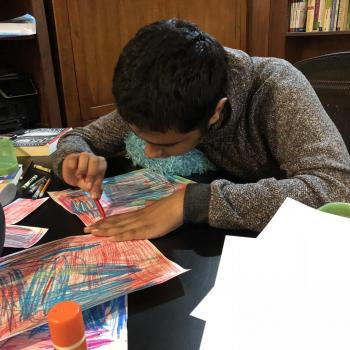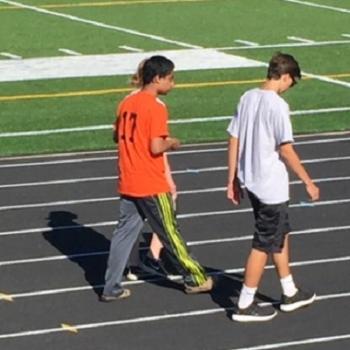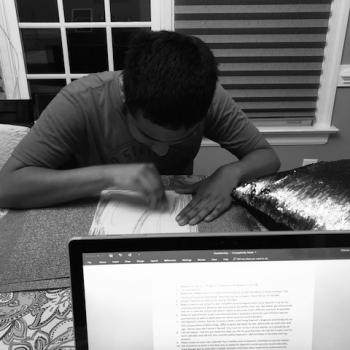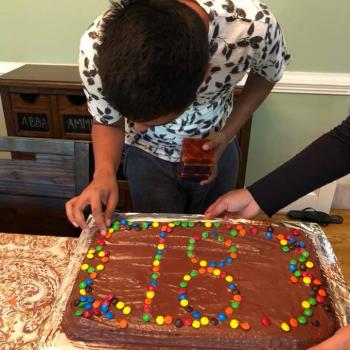 “Never be afraid to trust an unknown future to a known God.” — Corrie ten Boom
“Never be afraid to trust an unknown future to a known God.” — Corrie ten Boom
A soft plush white ball. A small turquoise blue-striped oblong pillow. A puppy-dog pillow pet. A fuzzy throw that is supposed to be draped on our sofa. These are the four go-to’s for D when he is feeling unwell or his anxiety is up, and he needs to stuff something up his shirt.
Usually the signs are clear and indicative of the level of his anxiety or well-being. The arms go in the shirt. The hood goes up on his head. Then he stuffs something up his shirt. And if doing all that doesn’t bring him the relief or sensory input he needs to feel better, then crying and wailing commences.
He’s got two or three of his go-to’s stuffed in his shirt today, giving him sort of a Santa Clause big belly. When I picked him up from school, two of his teachers escorted him down, holding big blocking pads just in case he tried to bang his head or body on something as they walked to my car. He was crying, arms stuffed in his shirt, as he climbed into the backseat. I drove him home, uttering my prayers, going over in my head what I could do to help bring him back to a good place.
It’s an autism cycle we can’t seem to break, the pursuit of calm we just can’t seem to help him master long term. A few good weeks or days followed by a cycle of unwell-ness, anxiety and all that it entails – pacing, stuffing, crying, meltdowns and my own personal waterloo – self-injury of some sort. Sure, we have things we do to help him, and we generally know what may be happening to him internally and externally.
But, do we really know? How can we every really know?
And how do we every get past this cycle of day-to-day to do some big-picture thinking for D? Parenting all our children requires some sort of big-picture thinking: Helping them find what they are passionate about, supporting them in their studies, driving, driving, driving them everywhere, gently guiding them to find the right friends and being there to advise and hold them when things fall apart, planning and saving for their futures, praying for their futures, nurturing their mind, body and soul.
That big-picture thinking gets awfully different when it comes to Lil D. At 14, he’s not so little anymore, and the past few months have been unavoidable lessons in how I need to not lose myself in the day-to-day – as hard as it is – and save some of my energy to focus on the future. Because it’s coming, no matter what we do.
……….
We’re sitting at a conference table in D’s school. His teacher, a few of his teaching aids, the program coordinator, his speech therapist, a special education transitions person, three of his home therapists, his dad and myself space ourselves around the table as we look at a big picture of D on the overhead projector. What’s the point of this again, my husband whispers to me.
To kick us in the pants and start thinking about D and his future, I reply back.
They call it a “person-centered” planning meeting, a fancy term for a meeting that occurs with anybody we feel knows D well, who can help us start thinking of where we want D to be in the future, and how to get him there. We will discuss what his likes and dislikes are, what his challenges are, and what we want for his future (this part has me fighting back tears). I want calm. I want his life full of dignity and respect. I want him happy.
But those are amorphous dreams needing tangible, planned steps for us to climb. An administrator at D’s school once wisely said to us – There are 24 hours in a day. Roughly eight are for sleeping, eight are for school or work and eight are for leisure activities. You need to be thinking about that as D gets older and how you’re going to fill those hours.
 It’s bemusing to think that we must help D figure out how to fill the hours of his day once his school days are over. The trending articles of late are about how we are an overscheduled lot of people, slaves to our busyness and playing a one-upmanship game of “I’m got so much on my plate .” And yet for D, too many unscheduled, unstructured hours can make him feel untethered – and not in a good way. Helping him find activities that he likes has always been the challenge, as well as motivating him to learn the things he needs to learn to survive in this world.
It’s bemusing to think that we must help D figure out how to fill the hours of his day once his school days are over. The trending articles of late are about how we are an overscheduled lot of people, slaves to our busyness and playing a one-upmanship game of “I’m got so much on my plate .” And yet for D, too many unscheduled, unstructured hours can make him feel untethered – and not in a good way. Helping him find activities that he likes has always been the challenge, as well as motivating him to learn the things he needs to learn to survive in this world.
We go back and forth at the meeting, the members of “Team D” talking about his strengths and ways we can begin exploring volunteer and other activities now, because we all know it’ll take years to find out what works for him, establish relationships with those in the community he’ll be working with and get him equipped with the tools he needs to fill his hours in a happy, productive and calm way.
At the end of the meeting, at my request, D comes down to the conference room and joins us. I want everyone to see him, really see the boy, the teenager, whom we are all discussing. This is who we are coming together for. This is the young man whose future we are trying to shape. And above everything, we must follow his lead and see where he takes us all.
We leave the meeting and my husband whispers to me again – So what was the point again? What did we accomplish there?
What did we accomplish, I say? It got us thinking about his future.
……….
Last weekend I attended a conference sponsored by the Autism Society of Central Virginia about post-secondary opportunities for individuals with autism. I learned about housing options, creating circles of support and care, getting funding for the future and other scary and exciting things individuals with autism and special needs as well as their families need to be thinking about. Sooner rather than later.
The last session of the day featured a panel of three adults with a variety of special needs. One of panelists was a guy I knew from our local autism community. I had vivid memories of when D was five years old in his autism school, and I would sit in the lobby and wait for him at pick-up time. John *, who was a teenager at the time would come up to me and always ask about my hair: What’s your name? Oh hi Mrs. Ali. Why do you wear that. Do you have hair? Want to see my hair? Does D have hair? Can I see your hair? (Until one day, just for him, I took off my hijab and let him see and touch my hair, which made him very happy.)
He sat the table with his mom and a young lady, who was his friend and care giver. And, with the help of his mom, he told us how he was living in a house with friends and how he liked it. John’s mom had set up a home with rotating young adults who helped look after him and to his utter delight, hung out with him as friends. I prayed – yes. Something like that for D.
After the session, an older man and I approached John and his mom to ask them more questions about how they had gotten John to where he was and how it was working; if this was something we could do for our kids. The older gentlemen told me his son was 25, and they wanted to get him into a more independent living situation before things became too difficult. How old is your boy, he asked me.
Fourteen.
It’s good, he said. It’s good you are here now, thinking about this.
……….
We are sitting around the dinner table. The kids have just finished reading the Quran with their Dadima (paternal grandmother), and I am wrapping up the day’s work and getting ready to make dinner. D is roaming around the house, stuffing his go-to’s up his shirt, and then taking them out once he has found his calm. He keeps grabbing my arm, trying to get me to give him candy. No, I say, we’ll be eating soon.
I think of what I discussed with his home therapists last night when I took them out to dinner to plan out the next things we would be working on with D. Every independent living skill, every home chore, everything we talk about is with an eye to the future – what can we do to help him help himself more?
All I want to do is think about the day-to-day. It’s enough to help D get through each day the best way possible. But we need to push our limits of enough – think bigger, aim further, plan for the future. Autism is his future, but it’s also so much more.
I plan, and God laughs – so the saying goes. But I’m praying that His laughter is His joy in revealing to us that which so scares me, so robs me of sleep and so shakes me to my very core.
A fulfilled future for D.











